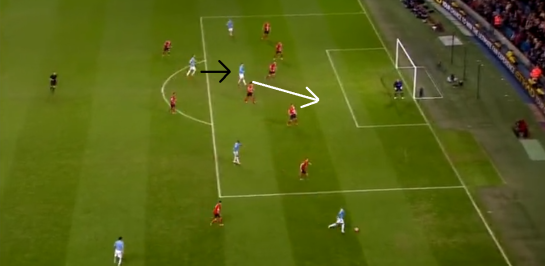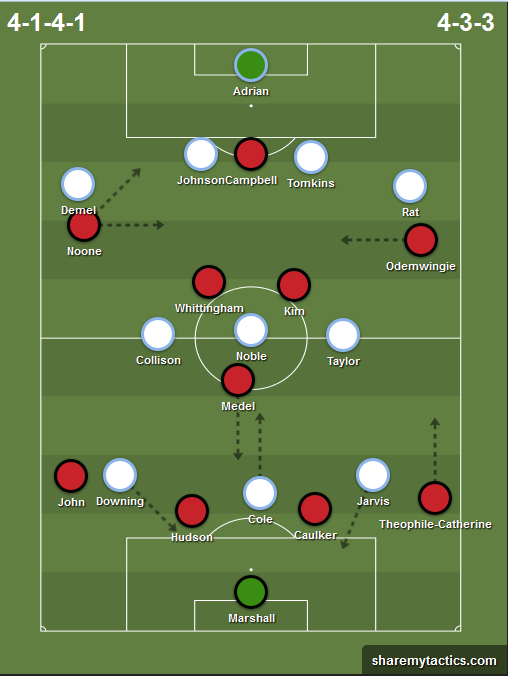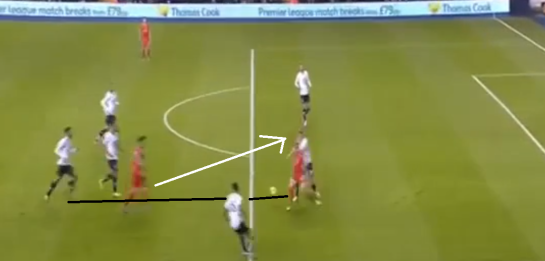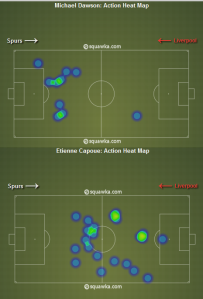Cardiff found themselves looking relegation firmly in the face after a 3-0 defeat to Crystal Palace, who should now have done enough to stay up. Defensively, Cardiff were as poor as they had been when losing 4-0 at home to Hull and these two performances stand out more than any others this season for the simple reason that neither opposition had to play that well to earn a comprehensive win.
In terms of positions on the pitch, Cardiff and Palace lined up in a similar way. One midfielder (Medel/Jedinak) sat in front of the back four, with a centre forward (Jones/Jerome) supported by a more mobile team mate (Campbell/Ledley) covering the width of the pitch, another (Zaha/Puncheon) staying on their flank and a midfielder (Mutch/Bolasie) playing box to box.
This graphical representation does not do justice to the different approaches of the teams. Pulis, as always, had his team well drilled and they frustrated Cardiff by allowing them to have possession along their back four and closely marking Cardiff’s attacking players further up the pitch, rather than using the current trend of pressing the opposition in their own half. The passing combination table below shows how often Cardiff could only seek out another member of the back four or Medel with the ball. In contrast, Palace’s most involved player was the attacking Puncheon.
Possession along the back four is not necessarily a bad thing but, despite having the ball, Cardiff did not have control. Good movement was needed in attack to create some space in the Palace half and this did not happen. With few clear options, Turner was often faced with the decision of another pass to Caulker or a raking long ball that was hit either too far to be chased or too hard to be controlled. This meant that when Palace gained possession they did so high up the pitch, which led to so much of their possession coming in dangerous areas -just 35% of Cardiff’s passes were made in the attacking third of the pitch, compared to 54% of Palace’s.
Daehli
Cardiff had started quite brightly, with Daehli standing out in the first 25 minutes. His quick feet frequently enabled him to lose his marker but there was all too often another Palace body, not to mention 50 yards of pitch, in front of him. After realising that he was the only Cardiff player looking to be creative, Palace concentrated on closing him down. A player with his attributes needs to be played further up the pitch; Jones supported by Campbell and Daehli might have worked better.
Instead, the Cardiff player with the task of creating a chance from dangerous positions was Wilfried Zaha. The loanee used the ball poorly, seeming to be more interested in beating a man with stepovers rather than crossing. Solskjaer has recently made a habit of withdrawing underperforming players in the first half but kept faith with Zaha for more than an hour. By this point, he had become the focal point for the crowd’s frustration as Cardiff chased an equaliser.
Puncheon scores
The game’s opening goal had come after half an hour, as Cardiff’s lack of defensive organisation told. Players looked unsure of their roles as Palace built a simple attack on the right flank. In the first screenshot below, Turner (black arrow) has raced out to close down Ledley, who had the ball in a vaguely threatening but not dangerous position – with only Jerome in the box, Turner and Caulker should have been able to deal with any cross. Once Turner left the backline, Medel (white arrow) moved back into his position.
On its own, this should have been fine as Cardiff had more than enough players defensively to deal with a short low ball into the area, but Puncheon (yellow arrow, below) found space by racing into the part of the pitchthat Medel had just left. He was then allowed enough time to take two touches to steady himself before firing a low shot into the net. Taylor and Mutch were too late to get their blocks in.
Having conceded this crucial goal, Cardiff did not change their approach until Zaha’s withdrawal on 60 minutes. During this opening hour, the only shot Cardiff had had on target was a deflected Campbell header while the game was still goalless. Cardiff continued to play into Pulis’ hands until Noone came on, after which his direct running and early crossing gave Cardiff some hope of an equaliser.
This proved to be shortlived when Medel overran the ball and resorted to pulling back Jerome in Cardiff’s half. Puncheon delivered the free kick well, but Turner lost Chamakh too easily for a free header, which was saved by Marshall into the path of another free player, Ledley. Once again, Cardiff’s players were without a clear idea of how to defend as a team.
The final substitutions changed little, with Bellamy taking Daehli’s place in midfield and, more bafflingly, Cowie coming on to play on the right wing in place of Jones up front. By now, the match was over and Puncheon topped off the win by curling in a very nice third goal as he took advantage of more space. Cardiff were a team counting down the minutes to the end of the game and perhaps to the end of the season.
Vincent Tan
It would be interesting to know Vincent’s Tan thoughts on the respective performances of the teams. Crystal Palace gave the sort of tight display that spelled the end of Mackay’s days at Cardiff and they picked up three points thanks in part to an increasingly ragged performace from the new manager’s team. It has to be assumed that part of Solskjaer’s remit when taking over was to play a more attacking brand of football but it has come at the expense of goals leaking in at the other end – one clean sheet in 2014 and twelve goals conceded in the last three games speaks for itself.
Does Tan regret losing the devil he knew for the devil he didn’t? Probably not, but the team certainly no longer looks as organised in defence and when the lineup and formation changes so much from week to week, it’s not surprising that players can seem a little confused. Pulis knows that a team will get nowhere until the defence is put right and this is why he will still be managing in the Premier League next season.
Graphics provided by:
sharemytactics.com
fourfourtwo.com/statszone
















































